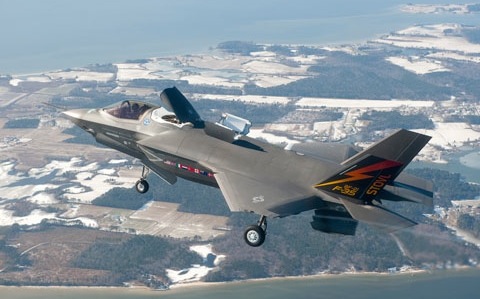F-35 Fleet Grounded: Air Show Flights May Still Happen
Posted on
UPDATED: F-35s Grounded, Say OSD, JPO. Still Hoping For Air Show Flights (Thursday 9 pm)
WASHINGTON: The Fourth of July may not be much of a holiday for the pilots and program officials trying to decide if the F-35 can fly safely to Britain after the recent fire at Eglin Air Force Base.
UPDATE One decision has finally been made. Late Thursday evening the Office of Secretary of Defense announced that the F-35 fleet was officially grounded. That’s right. Both OSD and the Joint Program Office used the term grounded, meaning the fleet will not fly until further notice and the causes of the fire have been found and ameliorating actions recommended.
“The technical air worthiness authorities of the Department of the Air Force and Department of the Navy have issued a directive to ground the F-35 fleet based on initial findings from the runway fire incident that occurred at Eglin Air Force Base on Monday, June 23. The root cause of the incident remains under investigation. Additional inspections of F-35 engines have been ordered, and return to flight will be determined based on inspection results and analysis of engineering data,” the release says.
The Joint Program Office release says teams searching for a cause of the June 23 fire “have been unable to pinpoint the precise cause of the malfunction.” The head of the F-35 program. Air Force Lt. Gen. Chris Bogdan release, said his people “aim to do what is prudent for the Enterprise at large without compromising the ongoing mishap investigation.” That language about compromising the investigation is a clear sign of the political sensitivities of the investigation.UPDATE ENDS
It’s already too late for an F-35B to make it to tomorrow’s christening of the HMS Queen Elizabeth, the British carrier from which the Bs will operate.
If the F-35B is going to fly at the Royal International Air Tattoo on July 11, then the four planes now at Naval Air Station Patuxent River probably need to take off no later than Tuesday morning. That would be cutting things very close, since the standard plan calls for the planes to have two days of maintenance and testing before flying again after their first trans-Atlantic crossing.
The planes could leave Pax River a day or two later and still make Farnborough, but that would also be cutting things pretty close.
The joint nature of the F-35 program is making the safety decisions much more complex to manage. NAVAIR is the air worthiness authority for the Marine aircraft and it would have to either issue a waiver to allow the planes to fly or to issue a preliminary finding that the planes are safe to fly. Their decision would presumably be derived from the facts gathered so far by the Safety Investigation Board (SIB), formed to analyze the fire’s causes and recommend how to cope with them.
The stakes are pretty big. You’ve got the head of Pentagon acquisition, Frank Kendall, and Air Force Secretary Deborah Lee James heading up a powerhouse US delegation, the biggest to hit an air show in year. If the planes don’t fly to and in England it is likely to be the biggest story out of both RIAT and Farnborough. “F-35 Fails To Fly At Farnborough; Critics Slam Costly Program” might make a good headline. I understand that senior officials in the Marines — remember that Commandant Gen. James Amos is the first pilot to lead the Corps and pushed hard for the F-35B to go to Farnborough in the first place — will weigh in. They hope to get a safety waiver.
“There is a concerted effort to get to that solution without compromising safety,” an official familiar with the discussions tells me. This is what has been in the works since the problems with the traditional process accident investigation process became clear. The Air Education and Training Command has sole authority to handle the investigation and to safeguard the plane from tampering because it controlled the plane. But that has meant the Joint Program Office, the Navy, other parts of the Air Force and the Office of Secretary of Defense didn’t know what was happening.
A process has been hammered out to maintain the rigorous investigation process and, at the same time, to ensure the rest of the military that flies the F-35. But this has made clear the need for a more regular process for future events and there may well be a formal Memorandum of Understanding needed to ensure the US military and the other F-35 partners can share information about systems common to all. Imagine hammering out an agreement that more than a dozen countries can all agree to. But it may be needed. But we’ll have to see if this is one of the lessons learned from the Eglin fire.
No preliminary accident findings are available yet. My colleague Andrea Shalal at Reuters has reported signs of extensive engine damage, with parts strewn across the runway at Eglin. Pratt & Whitney officials steadfastly decline to comment on the investigation, which is not unusual. Breaking D readers will remember the cracks in a turbine blade that grounded the F-35 fleet last year. The fleet was cleared to fly and we’ve no idea yet if the cause of the fire might be a cracked blade or something completely different.
Subscribe to our newsletter
Promotions, new products and sales. Directly to your inbox.

